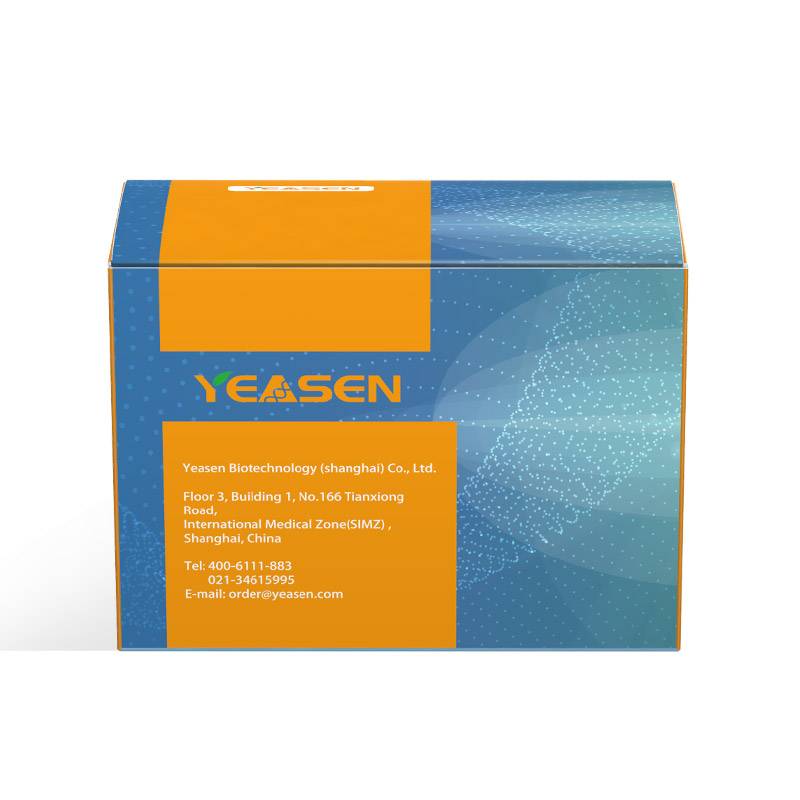Hieff NGS® Ultima Pro PCR Free DNA Library Prep Kit V2
Product Description
Hieff NGSTM Ultima Pro PCR Free DNA Library Prep Kit V2 is a new generation PCR Free library construction kit specially developed and designed for the Illumina® high-throughput sequencing platform. On the basis of the previous generation of library construction kits, this product exhibits higher efficiencies in end repair, dA-tailing, and adapter ligation than the previous versions. The kit is compatible with most DNA sample types, including standard genomic DNA from animals/plants/microorganisms, FFPE samples, cfDNA, and ChIP DNA.
Ø Suitable for 5ng-1000 ng of DNA, including FFPE, cfDNA etc.
Ø Proven to provide high-quality libraries and sequencing data.
Ø Strict batch stability.
Product Components
|
Component Number and Name |
12196ES08 |
12196ES24 |
12196ES96 |
||
|
12202-A |
|
Endprep Buffer 2.0 |
48 μL |
144 μL |
576 μL |
|
12202-B |
|
Endprep Enzyme 2.0 |
32 μL |
96 μL |
384 μL |
|
12202-C |
|
Ligation Enhancer 2.0 |
240 μL |
720 μL |
3×960 μL |
|
12202-D |
|
Kapid T4 DNA Ligase 2.0 |
40 μL |
120 μL |
480 μL |
Shipping and Storage
All the components are shipped with dry ice and can be stored at -20°C for one year.
Cautions
1 Operation
1.1 For your safety and health, please wear lab coats and disposable gloves for operation.
1.2 Thaw components at room temperature. Once the components are thawed, mix thoroughly by vortexing, spin the tube briefly and place them on ice for later use.
1.3 When preparing the reaction solution of each step, it is recommended to use a pipette to mix well or gently shake. Vigorous shaking may cause a decrease in library output.
1.4 It is highly recommended to use filtered pipet tips to avoid cross-contamination. Be sure to change pipet tips when processing different samples.
1.5 It is recommended to perform each reaction step in a thermocycler with a heated lid. The thermocycler should be preheated to the set temperature before use.
1.6 Improper operations may very likely cause carry-over contaminations through aerosols, impacting the experiment’s accuracy. It is highly recommended to divide the experiment environment into the pre-PCR and post-PCR regions, with separate sets of devices and disposables in each area. Perform routine cleaning for each area by wiping the surfaces with 0.5% sodium hypochlorite or 10% bleach.
1.7 This product is used for scientific research purposes only!
2 DNA Fragmentation
2.1 This kit is compatible with either mechanically fragmented DNA or enzymatically fragmented DNA.
2.2 The kit is compatible with 100 pg-1000 ng of input DNA. It is highly recommended to use high-quality input DNA with A260/A280 = 1.8-2.0. Table 1 lists the recommended amount of Input DNA.
Table 1 The recommended amount of Input DNA
|
Application |
Sample type |
Input DNA |
|
WGS |
Complex genome |
50 ng-1000 ng |
|
Targeted capture sequencing |
Complex genome |
10 ng-1000 ng |
|
WGS, Targeted sequencing |
FFPE DNA |
50 ng-1000 ng |
|
Targeted sequencing |
cfDNA/ctDNA |
≥500 pg |
|
WGS |
microbial genomes |
≥1 ng |
|
WGS (PCR-free) |
High-quality input DNA |
≥50 ng |
Note: When the input DNA is with poor quality or DNA size selection is required, the input DNA amount should be increased accordingly.
2.3 “Input DNA” specifically refers to the DNA samples ready for end repair/dA tailing.
2.4 A beads-purification/size-selection step is recommended post fragmentation if the input DNA sample contains high concentrations of salts like the metal-chelating agent. The salts might impact the efficiencies of the following reactions, including end repair and dA-tailing. Please elute the DNA samples in TE Buffer instead of sterilized ultra-pure water for fragmentation if using the mechanical fragmentation method. If using the enzymatic fragmentation method without performing beads clean-up or size-selection before proceeding to library preparation, please ensure that the stop buffer used doesn’t contain an exceeding metal-chelating agent. Otherwise, please clean-up or size select the fragmented samples and elute them in TE buffer or sterilized ultra-pure water (≤50 μL) before proceeding to library preparation.
3 Adapter Ligation
3.1 Yeasen provides the following barcoded adapters and index primers developed for the Illumina platform: 96 Single index complete Adapters: Hieff NGSTM Complete Adapter Kit for Illumina®, Set 1~Set 2 (Cat#13519-Cat#13520); 384 Dual CDI Primers:Hieff NGSTM 384 CDI Primer for Illumina®,Set 1~Set 2 (Cat#12412~Cat#12413);384 Unique Dual Index (UDI) Primers: Hieff NGSTM Stubby UDI Primer Kit for Illumina®(Cat#12404~Cat#12407);96 UMI UDI Adapters:Hieff NGSTM Dual UMI UDI Adapter Kit for Illumina®,Set1~Set2 (Cat#13370~Cat#13371).
3.2 The adapters’ quality and concentration will directly affect the ligation efficiency and the library yield. Too high concentration of adapters favors adapter dimer formation while too little adapter reduces ligation rate and library yield. Corresponding dilutions with TE Buffer according to Input DNA amount when using Adapter. Table 2 lists the recommended Adapter dilution methods for different Input DNA amounts using this kit.
Table 2 Recommended adapter: insert molar ratios for 100 pg-1000 ng Input DNA
|
Input DNA |
Adapter Dilutions ( Volume of Adapter : Total Volume) |
Concentration |
| 5ng ~ 10 ng | 75-Fold (1 : 750) |
0.2 μM |
| 10 ng ~ 24 ng | 15-Fold (1 : 15) |
1 μM |
| 25 ng ~ 100 ng | 7.5-Fold (1 : 7.5) |
2 μM |
| 100 ng ~ 1000 ng | 3-Fold (1 : 3) |
5 μM |
4 Bead-based Clean-Up and Size-Selection
4.1 DNA size-selection can be performed before end repair/dA-tailing, after adapter ligation, or after amplification.
4.2 It is recommended to perform size-selection right after adapter ligation if the input DNA amount is more than 50 ng; otherwise, please perform size-selection after amplification.
4.3 The Ligation Enhancer contains a high concentration of PEG, which may cause a significant impact on accurate size-selection. Thus, if size-selection is to be performed right after adapter ligation, it is strongly recommended to add a beads clean-up step before the size-selection. Size selection step can be performed directly if it is performed before the end repair/dA-tailing or after the library amplification.
4.4 The magnetic beads should be equilibrated at room temperature before use, otherwise the yield will decrease, and the effect will be affected.
4.5 Please thoroughly mix the beads before each use by vortexing or pipetting up-and-down.
4.6 Please be sure not to take the beads when transferring the supernatant, even trace amounts of the beads may impact the following reactions.
4.7 The 80% ethanol used for magnetic bead rinsing should be freshly prepared, otherwise it will affect the recovery efficiency.
4.8 For accurate size-selection, it is recommended to start with a volume of more than 100 μL. If less, it is recommended to bring the volume up to 100 μL with ultra-pure water.
4.9 The magnetic beads should be dried at room temperature before the product is eluted. Insufficient drying will easily cause residual ethanol to affect subsequent reactions; excessive drying will cause the magnetic beads to crack and reduce the purification yield. Normally, drying at room temperature for 3-5 min is enough to allow the beads to fully dry.
4.10 If needed, the purified or size-selected DNA samples eluted in TE buffer can be stored at 4°C for 1-2 weeks or at -20°C for about a month.
5 Library Quality Analysis
5.1 The constructed libraries’ quality is generally analyzed by measuring the concentrations and size distributions.
5.2 Libraries’ concentrations can be measured by fluorescent-based methods such as Qubit® and PicoGreen® or qPCR
5.3 It is NOT recommended to use absorbance-based quantification methods such as NanoDrop®.
5.4. It is recommended to use qPCR method for library quantification: fluorescent-based methods such as Qubit® and PicoGreen® cannot differentiate the incomplete dsDNA structures (inserts with no adapter or with only one of the ends ligated with adapter) from the complete libraries. The qPCR method will only amplify and measure the complete libraries with both ends ligated with adapters (the sequencable libraries), thus providing a more accurate measurement for loading.
5.5 The libraries’ size distribution can be analyzed using Agilent Bioanalyzer or other devices based on the principles of capillary electrophoresis or micro-control flow.
Catalog No.:*
Name*
phone Number:*
Lot:*
Email*
Country:*
Company/Institute:*





